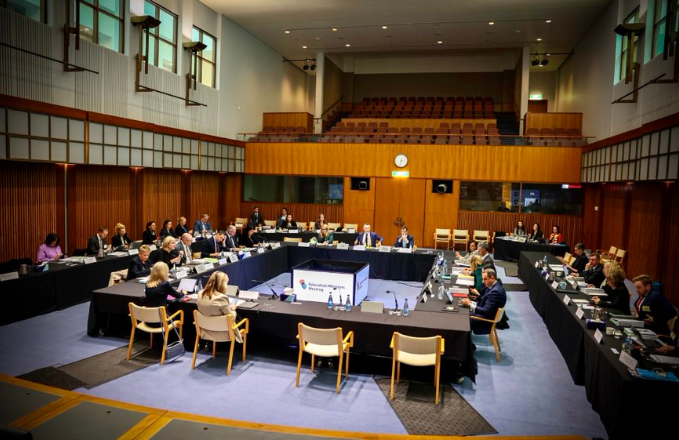
In March, the Federal Government announced an Expert Panel, chaired by Dr Lisa O’Brien, to advise on the key targets and reforms to be tied to school funding in the next National School Reform Agreement (NSRA).
Informing this Panel is a Ministerial Reference Group – chaired by Minister Clare and made up of teachers, principals, students, parent organisations, education unions, and other education experts and stakeholders – that will act as “a sounding board and source of advice”.
With just a few months remaining before the Panel is due to deliver its final report to the Federal Government, prominent voices in education are calling for bold reforms that do away with the thinking that caused the very problems schools are now trying to fix.
But when it comes to what reforms Australia’s schools need, it depends on who you ask.
To find out what kind of education system Australians want to see, Minister Clare released a new school reform consultation paper, which will accept submissions from the public until 11.59pm (AEST) on 2 August 2023.
According to The Australian Education Union, the reforms that the nation's schools need begin with funding every public school to 100% of their School Resourcing Standard (SRS).
“Ensuring every child has the opportunity to reach their potential can only be realised through a fully funded public school system,” AEU federal president Correna Haythorpe said. “But right now, 98% of public schools are funded below the SRS, which is the minimum amount governments have agreed is required to meet the needs of all students."
During the 2022 federal election, the Labor Party promised to deliver a ‘pathway’ to full funding for public schools. Haythorpe said the union is now making clear where that pathway needs to end.
“The Albanese Government must negotiate funding agreements with the states and territories that deliver 100 per cent of the SRS for every public school by 2028," she said.
“The Commonwealth must lift their contribution to public schools to a minimum of 25 per cent of the SRS, with this contribution guaranteed through legislation. Under the Morrison Government, public school funding was capped at 20 per cent of the SRS except in the NT which is transitioning down to 20 per cent."
Haythorpe said State and territory governments also need to "step up" their share of funding and ensure "every single cent" is used for the purposes of schooling, not for depreciation, transport or the costs of regulatory agencies, as is currently the case (outside of the ACT).
"These accounting tricks are costing public schools $2 billion a year. Finally, the Albanese Government must re-establish a permanent Commonwealth fund for public school capital works, ensuring public school students."
Meanwhile, Australia’s Catholic schools want to see national policy initiatives become more aligned to student outcomes and centered on a strong evidence base, with better planning and costed outcomes.
National Catholic Education Commission executive director, Jacinta Collins, said Catholic education values the Federal Government’s recognition of the importance of the non-government school sectors in driving reform and improved educational outcomes.
"As we have stated in our submission to the Productivity Commission’s review of the National School Reform Agreement, Catholic education would like to see national policy initiatives become more aligned to student outcomes and centered on a strong evidence base, with better planning and costed outcomes," Collins told The Educator.
"We would also like to see greater consultation in the development of national and bilateral agreements with the non-government sector from the outset, and funding for teacher professional learning opportunities, such as support for teacher curriculum implementation and developing rich formative assessment resources."
Collins also highlighted the importance of support for the implementation of "consistent, high-quality standards" in initial teacher education, and a national approach to child protection and safety registration.
Independent Schools Australia said it is "critical" that all school sectors, government, and non-government, are consulted and engaged in the development of the national and bilateral agreements.
"Reforms that support schools and teachers in supporting wellbeing and meeting the challenges of finding and retaining teachers are critical for every sector," ISA CEO, Graham Catt, told The Educator.
"Reform should be supported by a strong evidence base. Independent schools are able to trial and evaluate new programs and initiatives and are early adopters of new technologies and pedagogical approaches. They are uniquely positioned to contribute evidence and examples that can help all schools achieve meaningful reform."
Catt said that for non-government schools it is critical that resources are available to ensure that all schools have the capacity and the capability to engage in specific national reform initiatives.
"This support is particularly important as Independent schools do not have access to centralised support mechanisms, and the administrative and resourcing impacts of implementing national reforms, along with any subsequent reporting and accountability requirements fall directly on individual schools," he said.
"Independent Schools Australia is committed to collaboration with the whole education sector to achieve the best outcomes for all Australian school students."
Catt said ISA support the Government’s objective of ensuring all schools - regardless of sector – are funded to 100% of the Schooling Resource Standard by the end of the decade.
"All non-government schools will be funded at this level by 2029. Around 40% are still, as agreed with the Government, in the process of transitioning down to this level," he said.
"Under the current model, funding is based a direct measure of parents’ capacity to contribute, baser on their income tax. Schools with the highest capacity to contribute receive the least amount of government funding."


